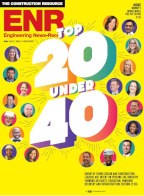As MEP engineer and energy and sustainability consultant for the Kaiser Permanente San Diego project, which is seeking LEED-Gold certification, Arup incorporated the first active chilled beam system within a U.S. hospital clinical environment. The firm also has consulted on several high-profile LEED-Platinum projects, including the San Francisco Public Utilities Commission building, completed last year.
Arup considers the social and economic aspects of its projects as well. "We see sustainability as quite broad in terms of how we can make a difference, not only in our own urbanized communities here in California, but using that knowledge and making a difference for people who might be needing it in developing countries," McConahey says.
Emphasis on diversity
Diversity also is important to Arup. Women account for 23% of the firm's technical staff, compared with an industry average of about 13%, says McConahey, who is also a trustee and the firm's regional diversity advocate. About 40% of newly hired college graduates at the firm are women, though only about 20% of U.S. engineering school graduates are female.
All new graduate recruits at Arup go on a three-day retreat to build teamwork and begin learning skills beyond their specialty in school. "We already value their single-discipline expertise, but we are playing a different game here and they need to learn how to play that different game peer-to-peer in order to deliver the combined solution," McConahey says.
Arup reinvests approximately 2% of its income into innovation and development of the firm. Employees can apply for grants to fund field-led research on any ideas that would benefit the firm.
"People often think about innovation as technical innovation, but often it's innovation in terms of practical aspects of how you design and construct something," Howard says. "We are finding that when your innovation is valued by a contractor, it's really quite rewarding because they have a reputation for caring about time, money and risk above all else. There's a crispness and a clarity to the bottom-line impact of your innovation."
The design-build Gerald Desmond Bridge benefited from this philosophy when Arup proposed design modifications to simplify an interstate interchange and the new cable-stayed bridge's tower design, trimming the contractor's bid price by $40 million.
"If our involvement can't significantly shift the price of the project, then we're probably not the right people to chase after the project with—contractors wouldn't find us attractive," says John Eddy, Americas infrastructure team leader.
Arup also chose a cable-stayed bridge design for the Transbay Transit Center in San Francisco. Whichever project is completed first will become the state's first use of a cable-stayed bridge for vehicular traffic.
Arup also is performing geotechnical engineering for the entire Transbay complex. Currently, foundations are being excavated to a depth of 65 ft. Because the site is surrounded by tall buildings, Arup is collecting some 2,000 separate readings there to monitor tiny ground movements. The information is provided to the client in real time via a digital dashboard that Arup custom-designed for this project.
Arup's employee owners find a strong sense of purpose in their work and social investment, Eddy says. He adds that at the end of the day, the staff "won't talk about the profits or the number of drawings or the long hours. They will talk about the benefit the project brought to the clients."










